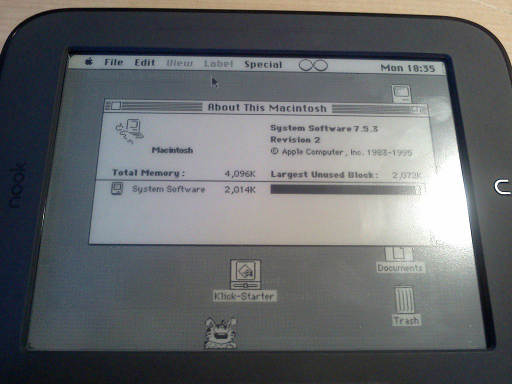Step 1) – The first thing you will need to do is download Mini vMac to your Android device from the Google Play Store by clicking here. It is compatible with almost any Android device running version 1.5 or higher. Step 2) – Next download the Mac Plus OS by clicking here. Over on the 68kmla forums, a website dedicated to old Macs built before 1994, zydeco released his Android port of Mini vMac, a Macintosh Plus emulator that puts the power of a Motorola MC68000 pr.
PowerPC G3/4/5
333MHz+
Free
run other OSes. Install the APK, place BIOS and Disk image labeled C.img in folder labeled 'SDL' on your SD card.You can download a Windows 95 image designed for this emulator from hereWe don't endorse nor recommend it since downloading the Windows image's legality could be questioned. Since it is closed source: We give the link for reference uses only.
An Open Source and minimal Macintosh Plus emulator for Linux-based operating systems
What's new in Mini vMac 3.5.8:
- Today’s Mini vMac 3.5.8 updates the stable version to fix a problem on PowerPC OS X, and also fixes an issue affecting the Variation Service. Mini vMac 3.5.8 on platforms other than PowerPC OS X (‘mach’), and x86-32 OS X (‘imch’), should be identical to Mini vMac 3.5.7, except for the version string and modification date.
- It was reported that “Mini vMac 3.5.7 wont run on PPC G3 systems”. It turns out that the GCC flag “-mmacosx-version-min” should be specified for all files compiled, not just the platform dependent code. It affects things like the required CPU. Making this change happens to have no effect on Mini vMac for x86-64 OS X, there is some effect for x86-32 OS X, and the largest effect is for PowerPC.
Mini vMac is an open source, free and cross-platform graphical software implemented in C and designed from the offset to act as an emulator for the Macintosh Plus computer system that was created by Apple, running on Linux, BSD, Microsoft Windows and Mac OS X operating systems.
Being one of the earliest Macintosh machines designed by Apple, Macintosh Plus runs only old Mac software, which, of course, does not work on recent Macintosh computers. Therefore, the Mini vMac software helps to preserve history. It has been designed to be as easy-to-use, portable and simple as possible.
Getting started with Mini vMac
To use the Mini vMac application on your GNU/Linux system, make sure that you download the binary package that corresponds to your computer’s hardware architecture, save the archive somewhere on your computer, unpack it and double-click the executable.
The application will open, notifying you that a ROM image of the Macintosh Plus system canont be located. This means that you will also have to obtain a vMac.ROM file (more details can be found on the project’s homepage) and place it in the same folder as the Mini vMac executable.
After you have obtained the Macintosh Plus ROM image, you must close the program and reopen it. If the ROM file is valid, the system will automatically boot and allow you to use it like you would use any other virtualized operating system.
Runs on all mainstream operating systems
This software is actually a spin off of the vMac application, which has not been updated in many years. For your convenience, it is distributed as pre-built binary packages for the aforementioned operating systems, supporting both 64-bit (x86_64) and 32-bit (x86) instruction set architectures.
The application’s source code is also available for download, for those of you who want to optimize the software for a specific hardware platform or operating system.
Filed under
Mini vMac was reviewed by Marius Nestor
Mini vMac 3.5.8
add to watchlistsend us an updateMini Vmac Android Phone
- runs on:
- Linux
- filename:
- minivmac-3.5.8.src.zip
- main category:
- System
- developer:
- visit homepage